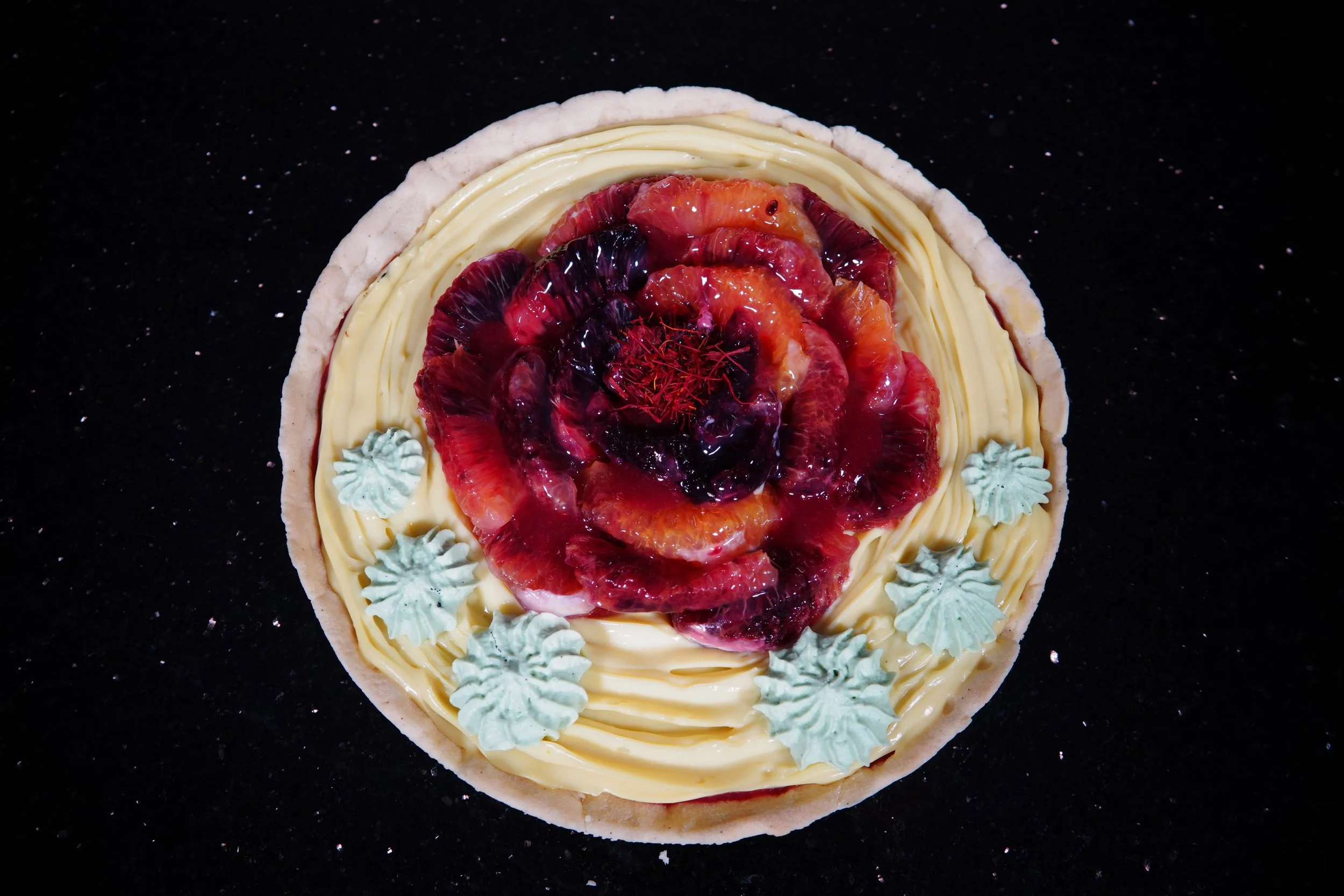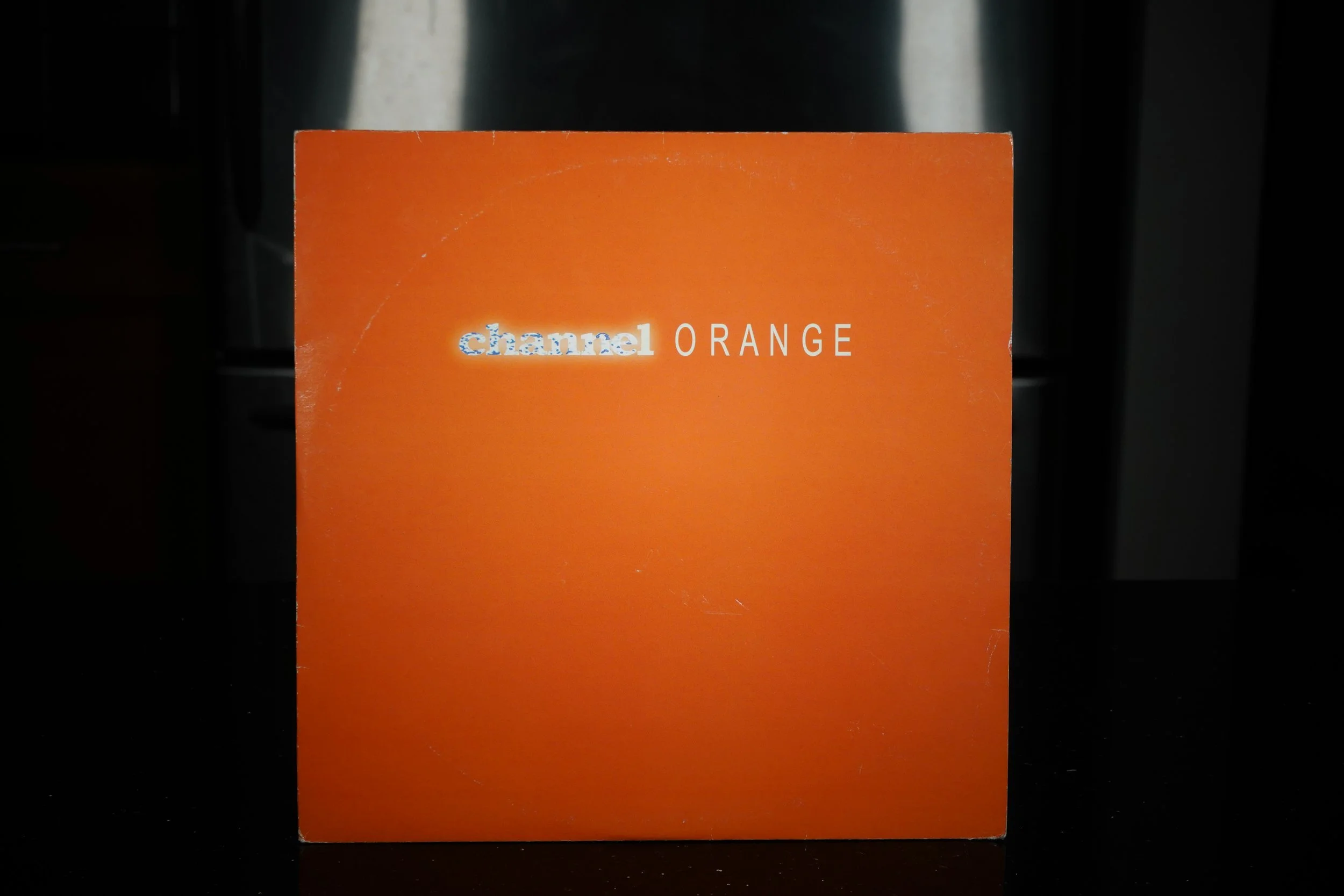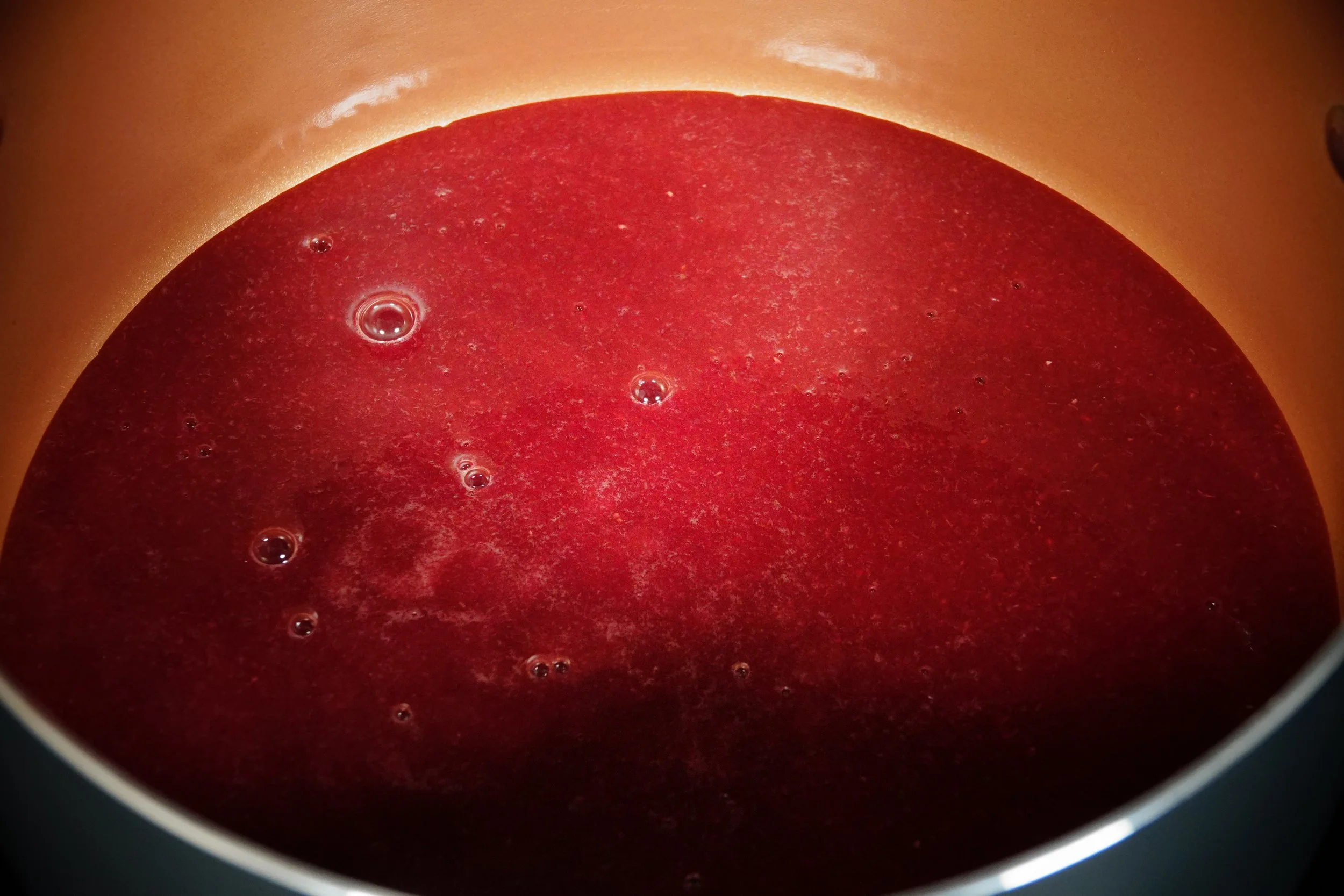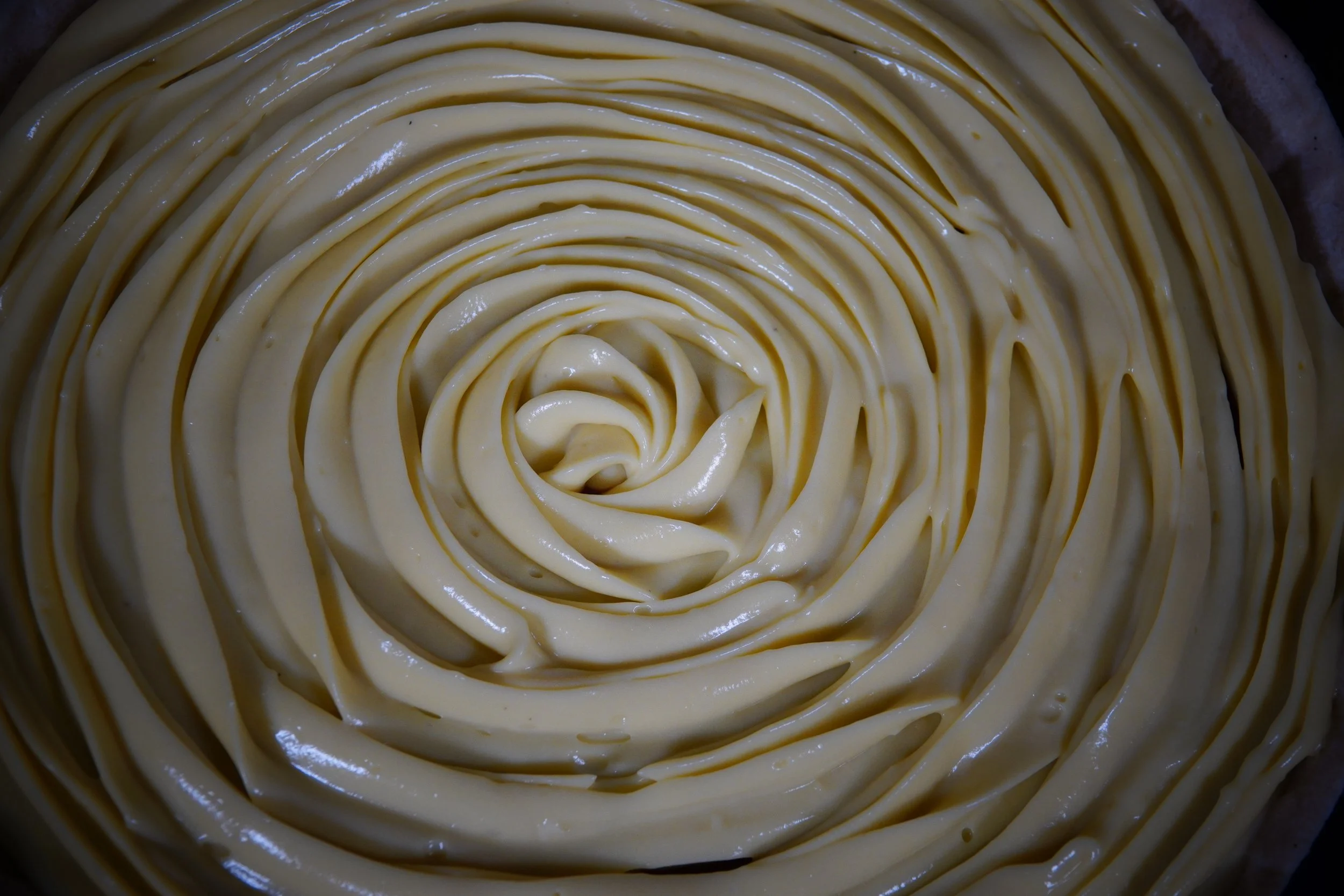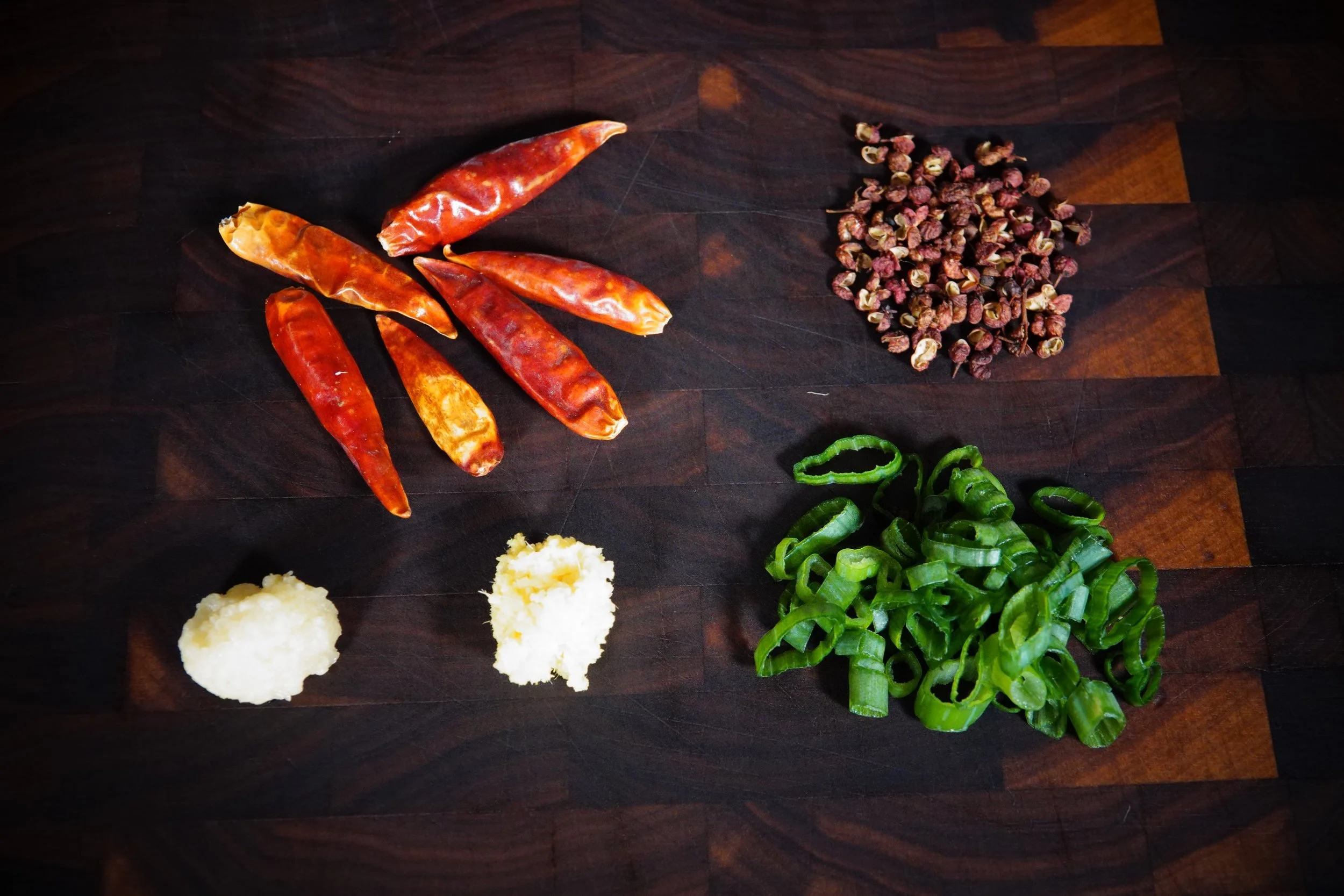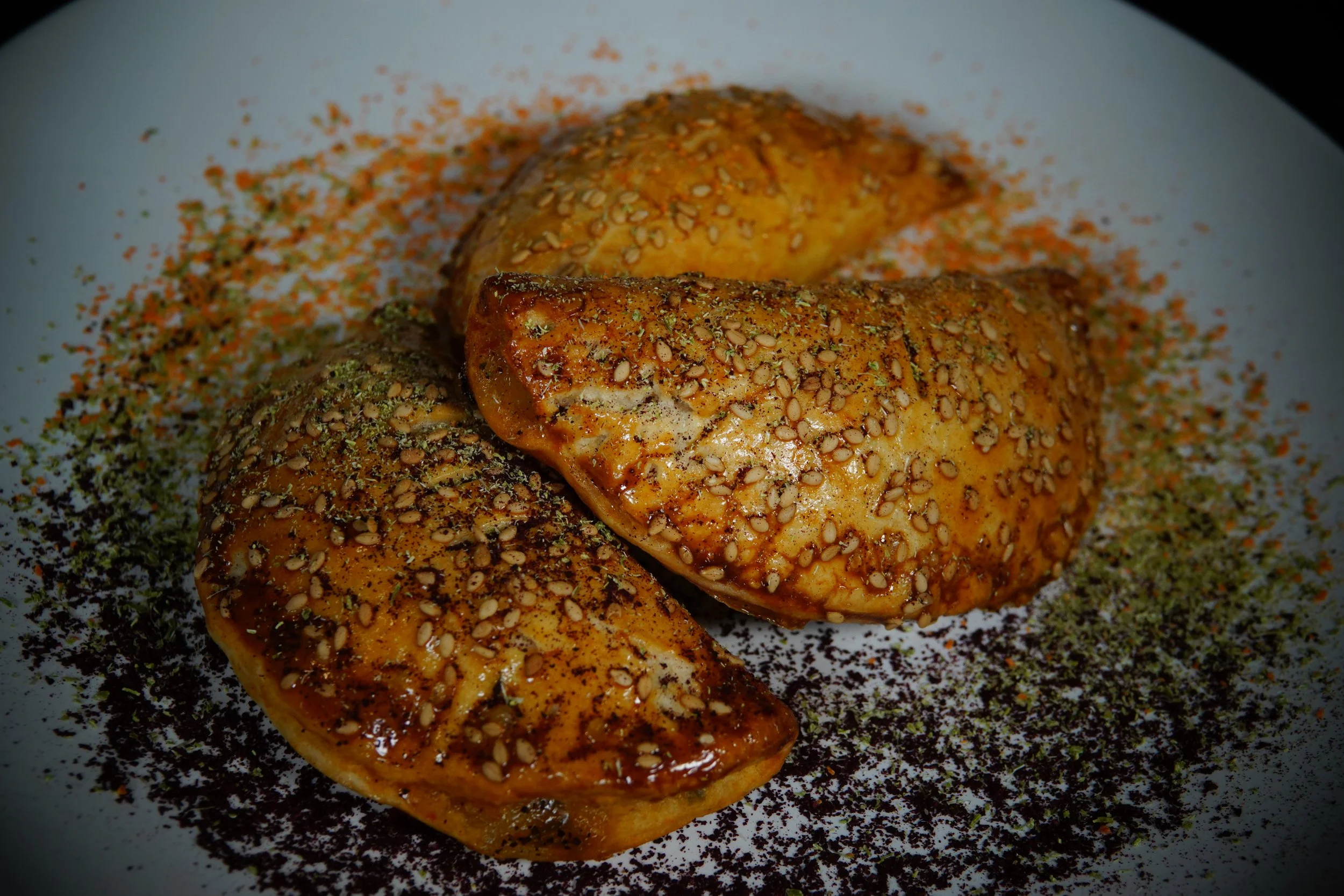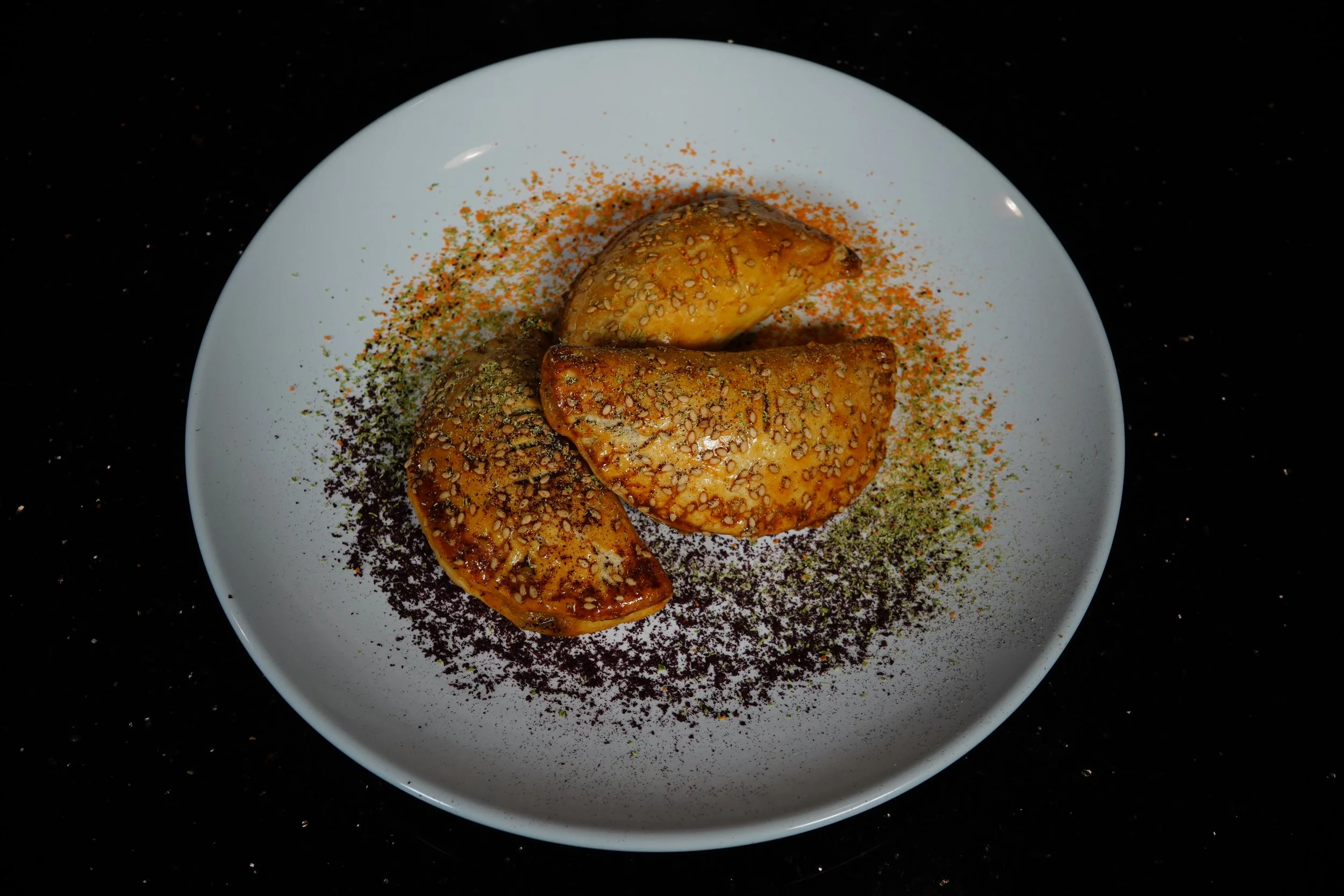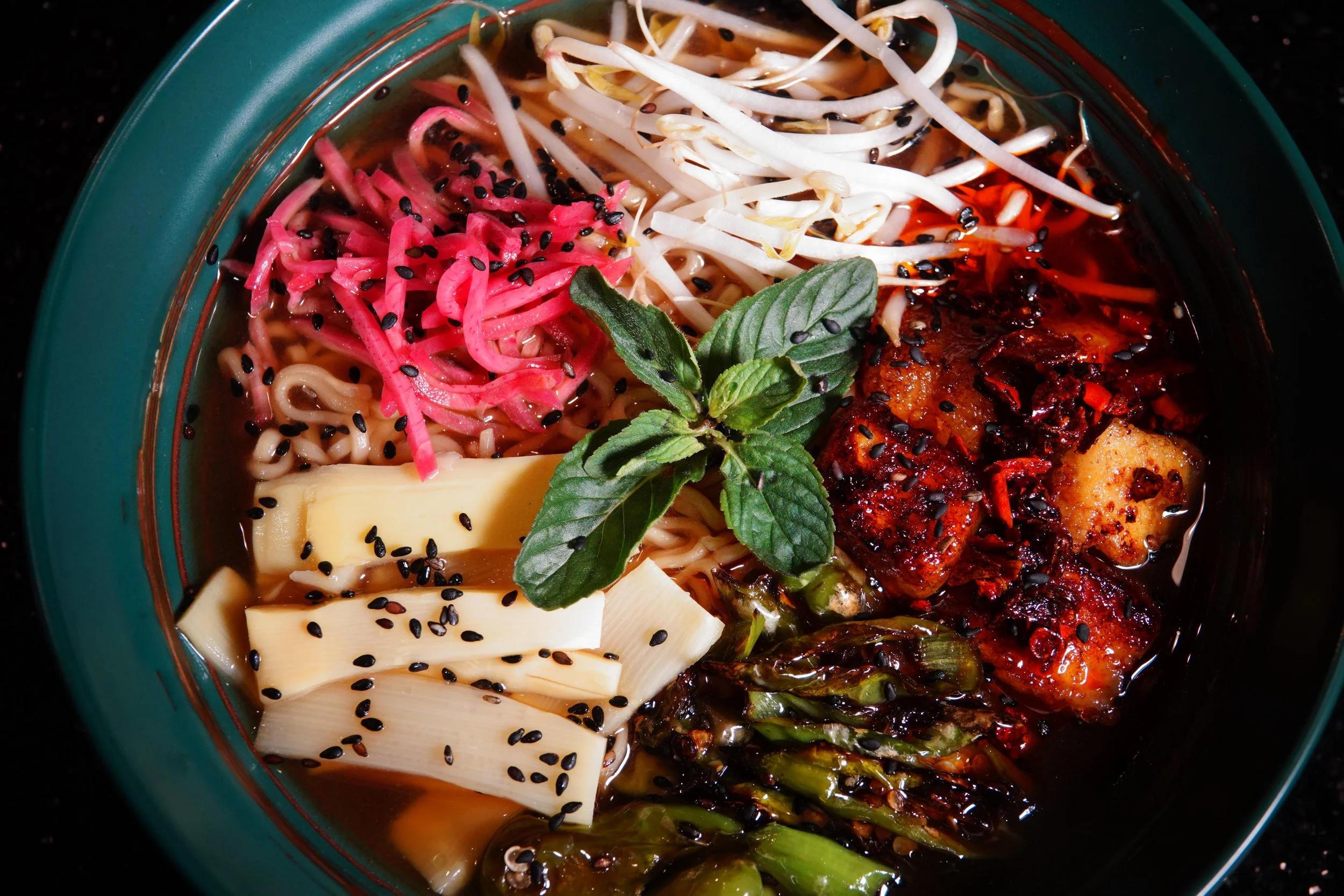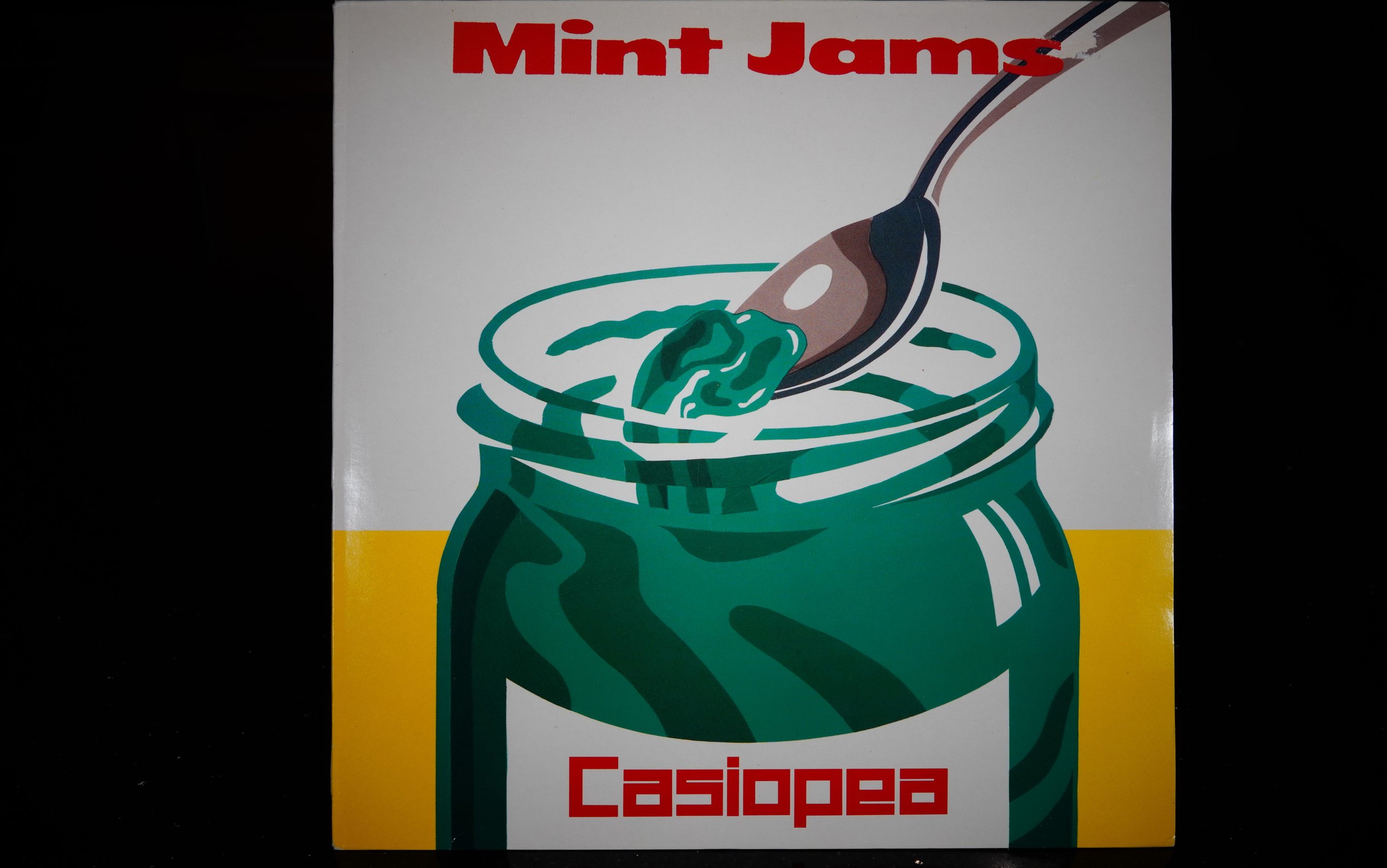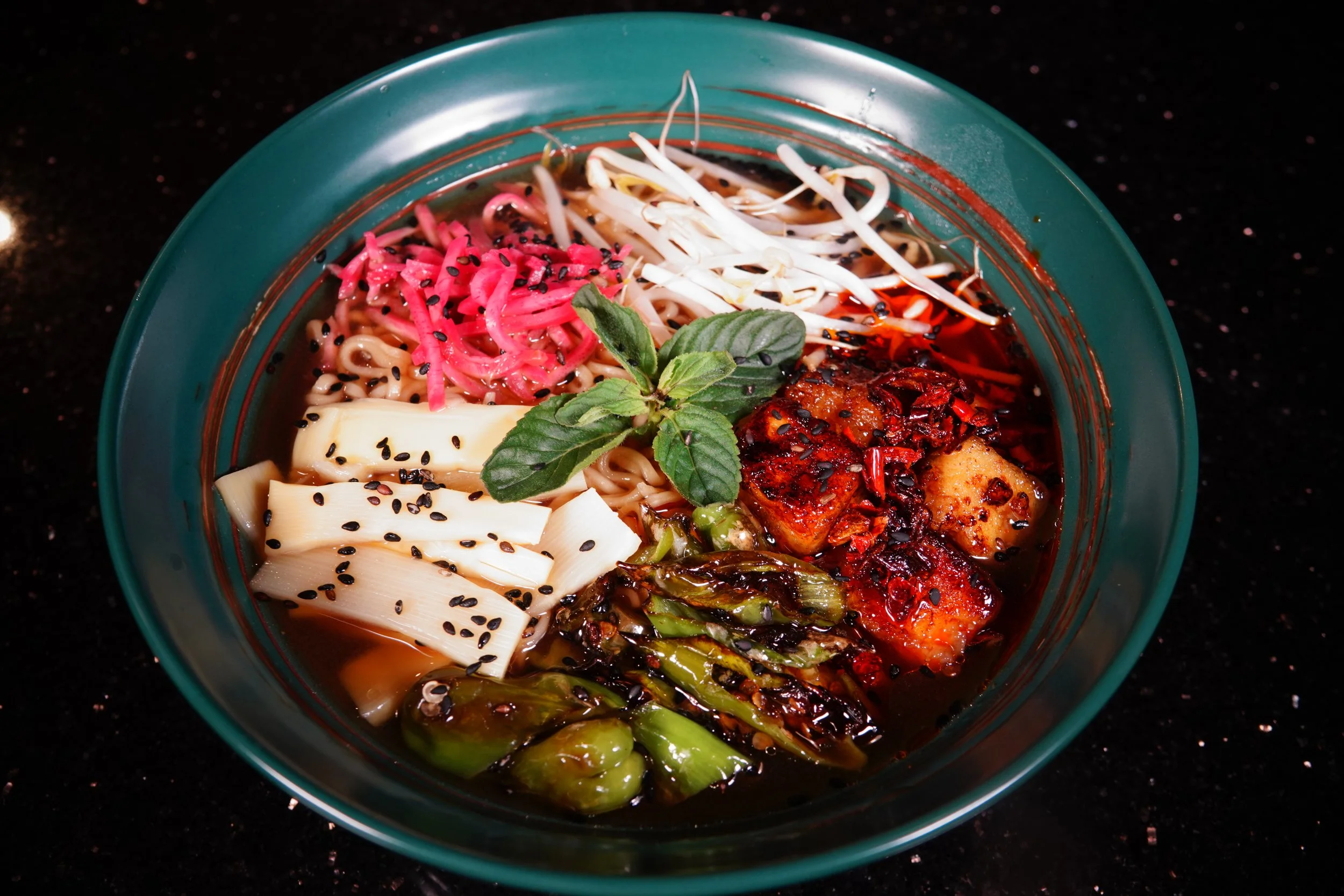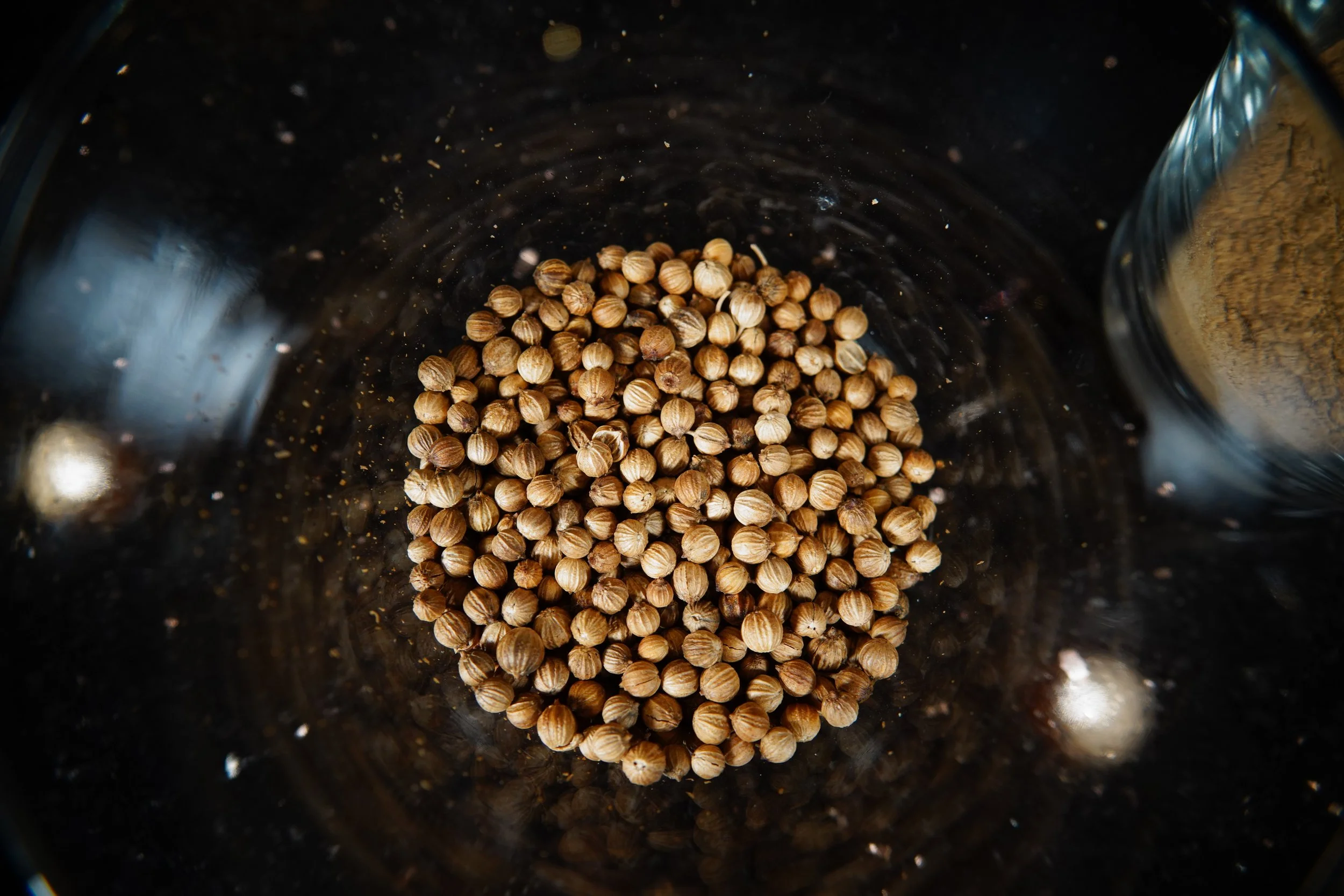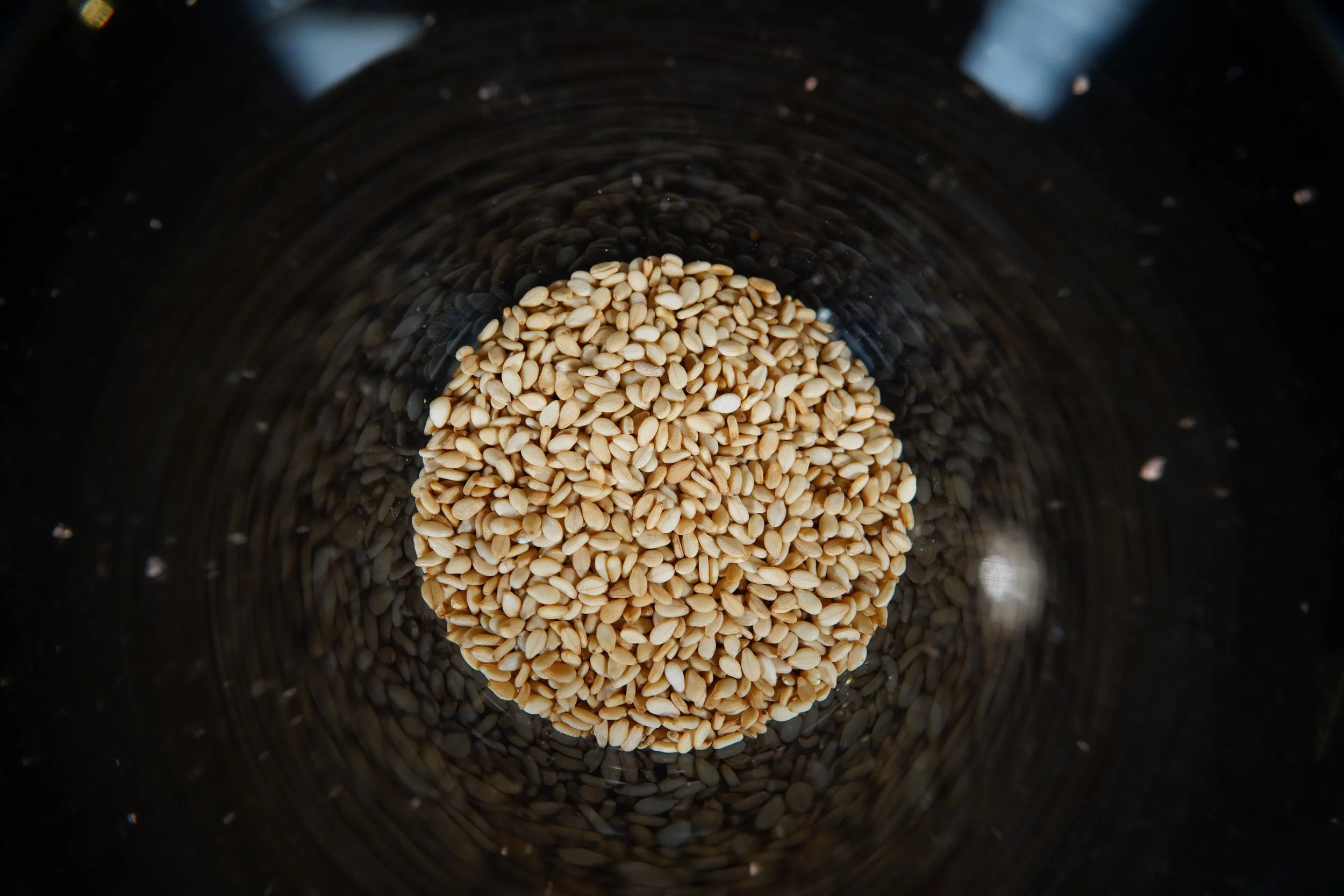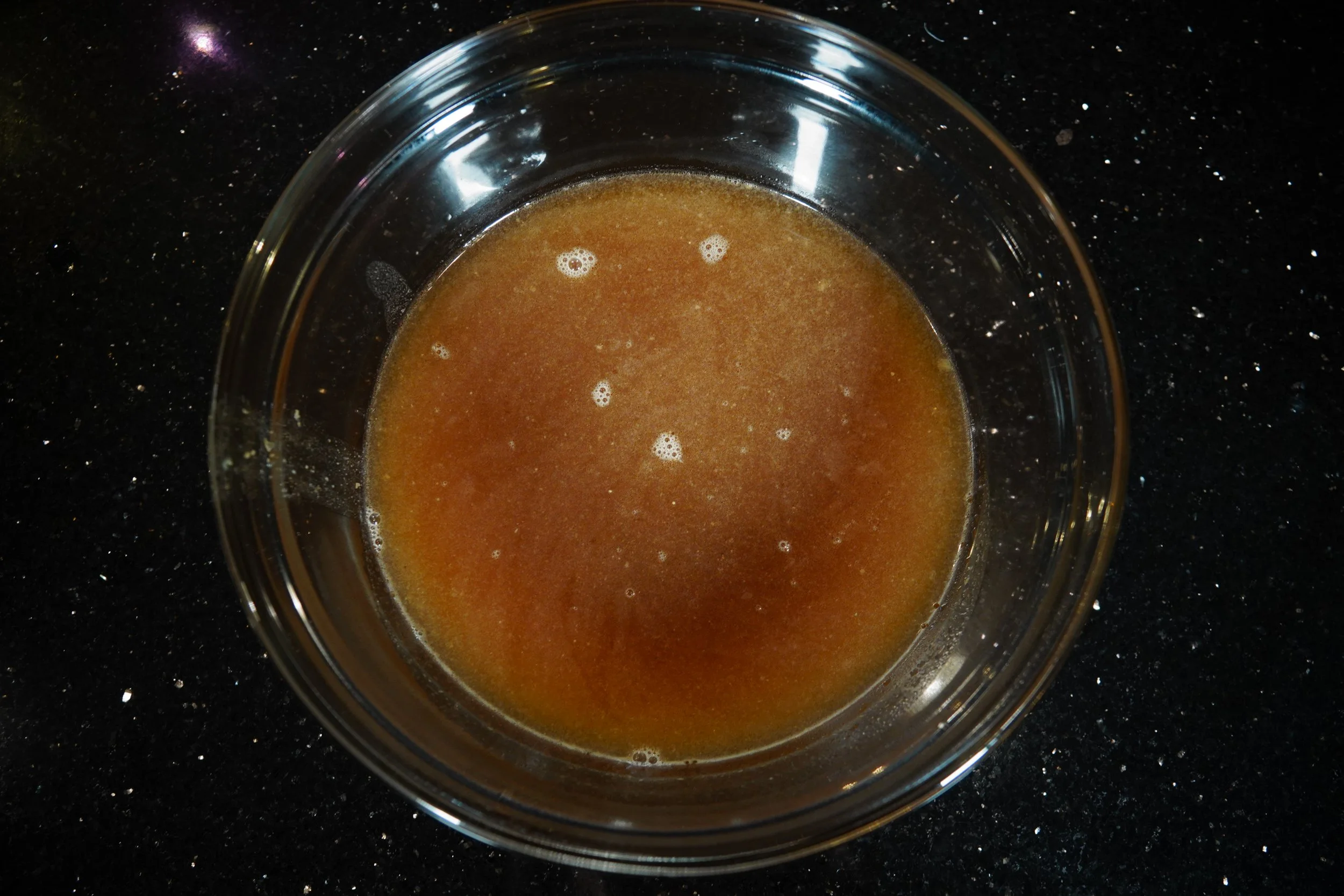Channel Orange by Frank Ocean - Blood Orange Saffron Pastry Tart
Channel Orange is poetry in motion, a grandiose drama of love and tragedy painted over ethereal instrumentals. Frank’s incredible lyricism stemming from personal experiences brings vivid stories to life with mysticism and relatability. The brilliant subject matter paired with a vintage sound and Hip Hop/R&B roots made me think of a delicate dish with sweetness and surrealism: Blood Orange Saffron Pastry Tart.
In 2012, the beloved yet mysterious Frank Ocean released a pivotal record in the wave of internet Hip Hop coming out of California in the early 2010’s, alongside records from Odd Future and The Internet. Channel Orange captured the hearts of millions within just days of its much anticipated and premature release. Prior to Channel Orange, Frank Ocean released his first mixtape, Nostalgia Ultra, for free on his Tumblr page, which left a massive underground fanbase hungry for more music. The Grammy award-winning record that Frank delivered cemented him as a generational talent and a cultural phenomenon.
Channel Orange is poetry in motion, a grandiose drama of love and tragedy painted over ethereal instrumentals. Frank’s incredible lyricism stemming from personal experiences brings vivid stories to life with mysticism and relatability. His conceptualization of a diverse cast of characters with constant references to historical figures and pop culture propels his stories of love and heartbreak into a mythological realm. Songs like “Monks,” “Pink Matter,” and the 10-minute ballad, “Pyramids,” depict potent dreamscape imagery, like stage diving Dali Lama’s, sparing sessions with “Sensei,” and Cleopatra’s lust. On the other hand, tracks like “Sweet Life,” “Super Rich Kids,” and “Lost” crash back down to earth with commentary on a luxurious veil blinding teenagers in suburban California. The heart-wrenching romance carried throughout the record takes on an entirely new perspective with Frank’s revelation of homosexuality. “Thinkin’ Bout You,” “Bad Religion,” and “Forrest Gump” are all expressions of him navigating his own sexuality, and though they may seem unisex on the surface, subtle hints reveal the complexity behind his words.
A few common themes dominate the diverse landscape of Channel Orange: surreal storytelling, the concept of “home,” and of course, troubled romance. Frank constantly flips between a dreamer and realist perspective, dramatizing feelings and emotions into surreal situations and following up with cold hard truths. Most of the record revolves around love and heartbreak, and no matter the dreamer or realist perspective, his stories hit close to home. In fact, the concept of “home” finds its way into quite a few of these tracks. Whether he speaks from the perspective of a lover reminiscing in his room on “Thinkin Bout You,” teenaged lovers living in their parents’ homes on “Sierra Leone,” or drugs leading to lost love and “abandoned homes” on "Crack Rock,” his association with love and home serves as a cornerstone for his storytelling. Not to mention arguably the best song on the record, “Super Rich Kids,” is literally a day-in-the-life story of wealthy kids being left unsupervised at home. His established setting of “home” brings a powerful sense of relatability to the record.
The brilliant subject matter paired with a vintage sound and Hip Hop/R&B roots made me think of a delicate dish with sweetness, surrealism, and the comfort of home: Blood Orange Saffron Pastry Tart. The themes in Channel Orange led me away from cooking and into the world of baking, because there’s just something about a fresh baked sweet that tastes like love and home. In this recipe, I made a beautifully infused pastry cream and piped it on top of a classic vanilla sable tart crust. I also made a blood orange jam to line the tart for an extra pop of flavor and color enhancement.
Beginning with the base of the dish, I made a traditional sable tart shell to act as the vessel for the pastry cream and fruit. Infused with fresh vanilla bean, the shell has a delicate sweetness and offers just enough texture to balance the layered toppings. The shell is the representation of the record’s foundational themes of love and home, which allow for imagination to run wild in both the album and the dish.
The orange jam layered onto the tart is both added depth of flavor as well as an ode to the album name and artwork. I blended fresh peeled oranges and let them simmer with sugar and pectin to form a beautifully consistent orange jam. With vibrant color and potent flavor, it cuts through the thick pastry cream and delicate sable shell.
Building on top of the shell and the orange jam, I captured the surrealism in Frank’s storytelling by infusing a pastry cream with a handful of dreamy spices: Saffron, Jasmine, and Vanilla. Saffron is the highlight of the dish, giving off a romantic spice to compliment the sweetness and providing a rich yellow color to the pastry cream. The significance of Saffron in Greek mythology as a medicinal and aphrodisiac spice, paired with its luxurious status throughout history made it a perfect match for the ethereal and cultured lyricism in Channel Orange. Lifted by delicate sweet notes of vanilla, herbal tones from the jasmine flower, and a hint of citrus from orange zest, the pastry cream makes for a celestial experience for the senses. If I could sum this flavor up in one song from the record, it would undoubtedly be “Pink Matter.”
Finally, the plating is my attempt to reflect the surrealism of Channel Orange over a blank canvas of pastel yellow pastry cream. I turned to the paintings of Salvador Dali to inspire a design that blends reality with imagination, much like Frank’s storytelling that constantly pivots from the dream world to the real world, and back again. The center of the tart layers orange slices to appear like rose petals, and piped-on matcha whipped cream resembles the look of the Olympic olive leaf crown as an ode to the mythological storytelling on the record.
Check out the full recipe here and stay tuned for the next album and recipe pairing!
Drunk by Thundercat - Kung Pao Chicken Wings
Drunk is a chaotic journey with a duality of care-free fun and complex feelings. The music inspired a recipe that throws correctness out the window for a fun and casual dining experience, while leaving an incredible depth of flavor that makes you wonder “what’s really going on here?”
Drunk is a chaotic journey that unveils the turbulence of life through curiosity, self-reflection, love, loss, and fear. The unfiltered lyrics and constantly changing rhythms create a rollercoaster of emotions that finishes with a six-song freefall. The overall feeling of this album is that life is so damn crazy, it’s worth laughing about.
The lyrics in the first stretch allow you to get comfortable in weirdness and humor, just like when the liquor starts talking. As the album progresses, we gradually see more substance, but always relieved by cool bumping rhythms and weird jazzy melodies. The lyrics resemble a running stream of consciousness, making them relatable as to how being a person really is. One minute you can be thinking about how cool it would be to be a cat, literally, and the next minute you’re second-guessing reality.
The album kicks off with “Rabbit Ho,” which introduces the liquid, existential sounds of the work as Thundercat invites us to “go hard, get drunk, and travel down a rabbit hole.” The next four songs flip the script to establish a basis for the sounds of the rest of the album. “Captain Stupido” sets the tone for the frequent (and much needed) comedic relief. “Uh Uh” is a display of raw talent, as he weaves his bass in and out of anxious jazz chord progressions. “Bus In These Streets” captures the first appearance of the Nintendo-sounding Japanese influence that plays a core role in this album’s identity. Thundercat is not shy in his admiration for anime, arcade video games, and Japan as a whole. Listen to “Tokyo”, you’ll get the idea. Finally, “A Fan’s Mail (Tron Song Suite II)” delivers the underwater groove that defines Thundercat’s style and makes a statement on the album’s biggest hit, “Them Changes.” These first five songs get us familiar with the different sounds, styles, and textures that Thundercat explores on the other 18 tracks of this masterpiece.
The last six songs of the record elicit overwhelming existential feelings that reflect what it’s like to spiral deep into your own head. Thundercat perfectly conveys the dangers of following those thoughts when they start down a darker path. However, the last song of the album, “DUI”, gives a breath of fresh air after all the chaos passes over. The lyrics in this one offer a rather comforting insight: At the end of the day, you just need to accept yourself and work toward who you want to be. Tomorrow’s a new day. Thanks, Thundercat.
In both the album and recipe, there is a duality of care-free fun and complex feelings. At the surface level, the base of this dish revolves around chicken wings. It encourages you to get your hands dirty, throw correctness out the window, and live in the moment. But after all the fun is over, it leaves you with an incredible depth of flavor that makes you wonder, “what’s really going on here?”
The Kung Pao sauce is the true heart and soul of this dish. It delivers a familiar sweet and sour profile before unveiling an eccentric numbing spice rarely found in Americanized versions. Where does that numbing spice come from? None other than the Sichuan Peppercorn, known not for its heat, but the unusual tingling sensation it distributes across the tongue and lips when consumed. It also carries beautiful floral flavors and aromas. One hell of an ingredient.
For one last compliment to the wings, I candied ginger to take this dish another step further in flavor dimensions and presentation opportunities. The purpose of the candied ginger, besides looking pretty, is to act as a palette cleanser to prevent the Sichuan peppercorn from taking you too far into its own world.
The Kung Pao Chicken Wings were inspired not only by the chaos and beauty of Drunk, but also its accessibility. The multicultural, jazz-born sound of Thundercat is truly complex. His ability to balance that complexity with the personal relatability of his lyrics makes the album shine, and this same concept is shown through the dish. Here, I’m conveying authentic Chinese cooking through the medium of the easily identifiable chicken wing. The recipe draws on cultural influences, while simultaneously expressing the conflicting sides of the human experience: unfiltered humor and social expressions, and internal battles with a constantly wandering mind. At first, you’re simply crushing wings, then, within an instance, a chaotic numbing spice is sending you head-first down the rabbit hole.
Click here for the full recipe. Compared to other recipes on this site, this one is relatively easy to make, and incredibly delicious! Enjoy the food and music and stayed tuned for the next recipe and album pairing.
Voodoo by D’Angelo - Etouffee Empanadas
D’Angelo’s Voodoo is a passionate composition that embraces the human experience, from irresistible natural pleasures to heavy hearted woes. Voodoo’s intimacy inspired me to create a hands-on dish that engages with the most basic, indulgent desires of good food: Etouffee Empanadas.
D’Angelo’s Voodoo is a passionate composition that embraces the human experience, from irresistible natural pleasures to heavy hearted woes. Its organic sound and stripped-down framework convey a sense of connectivity; music so embedded in its roots yet perfectly unique for its place in time. Recorded on analog equipment with live instruments for a vintage feel, Voodoo displays all the soulful, spiritual, romantic sounds of greats like Marvin Gaye and Curtis Mayfield, while channeling the street funk sounds of the 90’s Hip Hop movement. This blend of tradition and new age was D’Angelo’s breakthrough after years of frustration with the club/pop direction in which R&B music was headed at the time, as well as writer’s block of his own. In response, he revisited his southern church upbringing and African ancestry to create a piece of music that evoked powerful emotion. Whether it be Voodoo’s delicate vocal ad-libs or reversed soundbites, the lack of conventional structure expresses D’Angelo’s breaking down of walls and confidence in his true self.
Voodoo is straight up sexy. The slow seductive rhythms impose a gravitational pull, while audacious lyrics dance softly on your ears with an enchanting cadence. D’Angelo utilizes simple, steady-tempo percussion (courtesy of Questlove), swinging bluesy guitar riffs, soulful brass horns, and angelic vocal leads to portray pleasure, temptation, vulnerability, and desire. The raw, unfiltered style of the record gives a sense of empowerment to the listener, a validation of the feelings we experience around ourselves, the people closest to us, and the environments in which we live.
Voodoo starts off with D’Angelo flexing his masculine presence on “Playa Playa,” “Devil’s Pie,” and “Left to Right.” Flooded with Hip Hop percussion and heavy bass, he showcases his street side with a smooth operator tone. As the music progresses, D’Angelo’s vulnerability starts to peak its head on songs like “The Line” and “Send it On,” where he sings of the pressures and insecurities he faces. He gradually reveals his feminine side with tender vocals and strong emotions on songs like “One Mo’Gin,” “The Root,” and “Feel like Makin’ Love.” Finally, he taps into his roots for an emotional call out to both his ancestors and newly born on “Africa",” a powerful yet delicate final track that beautifully portrays his unification of old and new.
What Voodoo does best is bring us back to the simple pleasures of life. When I listen to songs like “Chicken Grease” and “Playa Playa,” I feel like I’m in the room with him vibing out as he improvises in real time. This intimate connection D’Angelo creates between himself and his listeners influenced me to create a hands-on experience that engages with the most basic, indulgent desires of good food. A dish so richly rooted in cultural traditions that its flavor is unmistakable and unwavering. A soulful plate that’s by no means good for you, but that’s why it’s so damn appealing. Unpolished, messy, flat out sexy; irresistible flavor with a spellcasting first bite: Etouffee Empanadas.
The Etouffee Empanadas are delicate flakey pastries caressing a rich sauce-bound filling, exploding with flavors native to the Louisiana area, famously New Orleans. However, the cultural roots of the food and music go back even further to ancient African traditions, as D’Angelo explains in an interview from 2000, “I named the album Voodoo because I really was trying to give a notion to how powerful music is and how we as artists, when we cross over, need to respect the power of music. Voodoo is ancient African tradition. We use ‘voodoo’ in the drums or whatever, the cadences and call-out to our ancestors and that in itself will invoke spirits. And music has the power to do that, to evoke emotions, evoke spirit. That’s something I learned in the church when I was very young and that’s what I wanted to get across” (Jet, 2000.) Taking inspiration from African, Creole and Cajun cuisine, this plate holds a long lineage of authentic culinary traditions.
The empanada filling is a mixture of etouffee, a rich seafood stew, and jollof rice, a popular rice dish in West African cuisine. Etouffee is a staple in both Cajun and Creole cooking, a flavor bomb of seafood broth binding a dynamic blend of vegetables, seafood, herbs, and powerful spices. Its cultural roots are apparent by the name, the preparation, and the flavor, a dish created for and by the people. I wanted the Etouffee to be at the center of the dish, along with the direct tie to Africa in the jollof rice to capture the cultural roots that so wonderfully encase Voodoo.
The intimacy of the dish comes through as a delicate, savory pastry wraps up all the warm, powerful flavors of the etouffee and jollof. The pastry is mainly a representation of D’Angelo’s feminine side, the tender vocal work and emotional vulnerability. But it does something else as well; stuffing the etouffee in a flakey pastry enables you to have an intimate experience. It encourages you to eat with your hands, to dive in, indulge and get messy with pleasure, not shame. The empanadas also ensure that your first bite is just as delicious as your last, which reflects the level of cohesion maintained throughout the record.
Ironically, the album title is “Voodoo,” which is a defining characteristic of New Orleans culture, a connection I didn’t even make until after I came up with this recipe. So, to shoutout the Cajun and Creole roots in this dish, I garnished the empanadas with a few different powders made of beets, celery, and carrots for a New Orleans color display.
I hope you enjoyed the recipe and album breakdown. Visit the recipes page to get a hold of the recipe. Take your time with this one, the recipe is a bit more intensive but can easily be spread out over a few days. The album is kind of the same, the shortest track is 4 minutes and 38 seconds and takes some commitment for a full 1 hour and 18-minute listen through, but making it through to the end is worth every moment. Until next time.
Mint Jams by Casiopea- Ramen
Gleaming city lights. Crisp, late-night air. Effortless movement and captivating adventure. Mint Jams is a soulful ride through the 1982 Tokyo streets that warms your heart like your favorite childhood memory.
Gleaming city lights. Crisp, late-night air. Effortless movement and captivating adventure. Mint Jams is a soulful ride through the 1982 Tokyo streets that warms your heart like your favorite childhood memory. Casiopea’s mesmerizing live performance delivers an intricate Japanese Jazz Fusion record that radiates flashing sound in every direction. From nostalgic refrains to energizing solos, Mint Jams will have you eagerly anticipating what’s next while sitting in awe of what you just heard. This album is a gem, a brilliant body of work by one of Japan’s most influential music groups, Casiopea. The group has released over 30 albums since their debut record Casiopea in 1979, and many of the early members hold musical significance in other areas of Japanese culture, like Minoru Mukaiya, (keyboardist) who composed over 200 distinct melodies for different train stations throughout Japan based on his expression of what each area sounded like. Casiopea’s musical prowess allows for impeccable precision and raw emotion on Mint Jams (1982); an action-packed 36-minute record that will leave you better than when you found it.
The album kicks off with “Take Me,” a magnificent display of feel-good pacific sounds that establish a sense of wholesomeness carried throughout the rest of the tracks. “Asayake” follows, laying down a nostalgic 80’s guitar riff overlayed with a dreamy synthesizer. As the song progresses, the intensity on guitar picks up, introducing the first flavors of energized soloing that works in tandem with up-tempo bass lines. Next is a minty-cool jam that embodies the album’s essence, “Midnight Rendezvous.” This track makes me feel like I’m in the Mushroom City map in Mario Kart: Double Dash. Its irresistibly funky synth and bass lines set the stage for the guitar to effortlessly cruise, leading to an awe-inspiring synthesizer solo and electrifying ending. To keep the energy high, “Time Limit” showcases Casiopea’s raw talent, as the group plays as fast as humanly possible to squeeze every note into their shortest track, sitting at 2 minutes and 35 seconds. Their lengthiest track, “Domino Line,” comes next with a return to sounds of video game-nostalgia that were sprinkled throughout the opening songs. This one has the classic lighthearted 80’s feel heard earlier in the record, and quite a bit of showmanship. The keys, guitar, bass, and drums all claim their own solos, following each other back-to-back in a domino line as the song title suggests. Finally, we hit the apex of the record with “Tears of the Star,” a song that sounds exactly like its name. The slowed pace encourages you to soak up the moment as Casiopea takes you on a rollercoaster of emotion to reflect on how far the seemingly innocent album has come. Lastly, the grand finale, “Swear,” brings the album to a bittersweet close, coming back full circle to the breezy island feel from the very first track. Combining all the best elements from the record, “Swear” delivers one last wholesome refrain accompanied by walk-off solos from both the keys and the guitar. In the final moments, Casiopea gets the crowd involved to remind you that this powerful piece of music happened in front of a live audience on a February night in Tokyo, 1982.
Best Song
Midnight Rendezvous. Honorable mention Tears of the Star
Best Moment
Finale of “Swear”
The recipe I came up with for Mint Jams is a unique rendition of an all-time favorite food of mine to complement an all-time favorite album. Ramen seemed like the obvious choice, as the music encapsulates so many elements of Japanese culture and sounds like it belongs in a Nintendo game. Ramen is a Japanese staple loved by virtually everyone on the planet; the warmth and comfort of broth and noodles paired with simulating toppings makes for a truly blissful experience. In this recipe, I upped the energy and adventure to capture the invigorating zing, dreamy mysticism, heartwarming nostalgia, and calculated coolness of Mint Jams.
To stay true to the distinct Japanese sound of Mint Jams, I wanted the base of my Ramen to have traditional Japanese flavors. I also wanted it to be light and clean because the album displays so much musical precision. So, I started by making ichiban dashi, a broth made of kombu (dried kelp) and katsuobushi (dried fish flakes). This gives the broth an umami ocean flavor that brings out the feel-good island vibes of the record, and its simple ingredients keep any fats from oversaturating.
The base of the broth is built around four spices: sumac, coriander, cardamom, and sesame (not really a spice but in this case, using it as such). Sumac sets the first pillar of the album with its high acidity and citrus-like flavor to embody the energized synchronization that we hear on “Time Limit” and virtually every track. The cardamom displays the fragrant dreaminess from the synthesizer used all over the record, like in the opening of “Take Me” and “Tears of the Star.” Coriander acts as the perfect complement, bringing a refreshing balance to the mix with a mellowed out citrusy tang to capture the effortless riffs and vibe-riding leads of “Asayake,” “Midnight Rendezvous,” and others. Lastly, the ground sesame keeps us rooted in the Nintendo nostalgia with a familiar Japanese flavor profile we hear on “Domino Line” and “Swear.” After lightly sautéing garlic, shallot, and ginger to build umami, I add these spices to the pan along with a bit of honey for a touch of sweetness and deglazed it all with the Ichiban Dashi stock. Once comes to a simmer, I add tare (a mixture of shoyu, sake, mirin, and brown sugar) and white miso to develop a distinct ramen taste. Additionally, I add a few squirts of lime juice for a bit more zing than usual to keep up with the energized pace of the album.
Finally, I incorporate a few different herbs that, like the spices, reflect some of the main sounds of Mint Jams. The first is, you guessed it, mint. It’s in the album title, so I couldn’t leave it out. But that’s not the only reason it’s in here, mint brings a sense of refreshing coolness to the broth that cuts through the commotion. The next is basil, which does much of the same as mint but adds a bit more sweetness that contributes to the feel-good vibes of the record. Lastly, green onion plays into the traditional Japanese profile while offering another bright, crisp, umami flavor.
The toppings on the Mint Jams ramen dish are an ode to the frequent soloing we hear from track to track. They all have a way of capturing the same elements of the album we put into the broth, mainly the high acidity, dreamy sweetness, palate cleansing refreshment, and Japanese umami. The pickled ginger serves as a crunchy and tangy topping to convey the high energy. The tofu glazed with a ponzu captures the dreamy sweetness and finishes with a bit of heat from a chili crisp garnish. The bamboo shoots and bean sprouts serve the palate cleansing role that the mint and coriander play. And finally, the shishito peppers, like the grand finale “Swear,” offer us a last bittersweet flavor as the caramelization of the peppers balances out their natural bitterness.
I hope you have as much fun listening to this album and making this recipe as I do. Not only do the flavors encapsulate the sound, but the colors of this dish paint a beautiful picture of the record. Keep an open mind when plating your ramen bowls, it’s a freeform dish so the possibilities are endless. There is no one-star of the show, so you can get creative here and come up with exciting placements. Visit the Recipes page to find the full-length recipe walkthrough. Thank you for checking out this recipe and album breakdown!
Mm.. Food by MF DOOM- Nachos and Beer
Mm.. Food is an eccentric record where mischievous rhymes wreak havoc over cartoon-sampled beats. Throughout the journey, you’re bound to laugh, make the stank face, and let some of DOOM’s street wisdom marinate on your mind.
Mm.. Food is an eccentric record where mischievous rhymes wreak havoc over cartoon-sampled beats. Throughout the journey, you’re bound to laugh, make the stank face, and let some of DOOM’s street wisdom marinate on your mind. This album is nothing short of entertainment, in fact, you’ll often find yourself feeling like a kid watching Saturday morning cartoons. Its pure fun to listen to DOOM spit witty rhymes about himself in the third person and cut cartoon dialogue samples to tell the story of Hip Hop’s “comedic villain.” His use of humor in the context of the street life makes for a record that is simply raw rhymes and good times.
The most impressive thing about Mm.. Food is how DOOM jam packs samples on top of each other to turn them into one cohesive piece, following the same philosophy with his rhyme schemes. For example, in the opening song, “Beef Rap," DOOM layers eight different dialogue snippets from movies and cartoons over a beat that samples an episode of the 1982 Marvel Spider-Man show, featuring the villain Dr. Doom. Likewise, his bars are filled with ridiculous rhyme schemes and colorful vocabulary, sometimes not even making sense, but always sounding perfect.
Best Bars
I’ve listened to this record so many times, and still DOOM’s lines never fail to make me laugh or feel the heat. I listed out my five favorite lines from Mm.. Food and the songs they come from, so you won’t miss them when you listen.
“Here I am known for giving heavy back aches, grown and living off of Lil’ Debbie snack cakes.”- “Kookies.”
“As I reminisce never forgot when I was very broke, shot the henny straight couldn’t afford to cop the cherry coke” – “Kon Karne.”
“He wears a mask just to cover the raw flesh, a rather ugly brotha with flows that’s gorgeous.” – “Beef Rapp.”
“Light the Doobie til’ it glows like a ruby, after which they couldn’t find the villain like scooby.”- “Beef Rapp”
“He'd rather eat a sand sandwich salad, it might need salt like your man's bland ballad.”- “Vomitspit”
Best Song
The biggest hits off this record are “One Beer” and “Rap Snitch Knishes,” but my favorite song is the opener: “Beef Rapp.” The first minute and 46 seconds is so strangely appealing, it sucks you right into the bizarre world of the “Supervillain” and includes dialogue samples about food to set up the album’s theme. Then, DOOM drops one of the dopest beats I have ever heard, which is a sample from “Spiderman: The Canon of Doom” (1982). This beat is the epidemy of DOOM’s sound and style on this record, and the rhymes he delivers are a masterful blend of humor, heat, and storytelling. “Beef Rapp” is easily one of my favorite DOOM songs of all-time.
The Nachos
In this recipe, I wanted to follow DOOM’s jam-packed strategy: A dish full of exotic flavors piled on top of each other. I wanted to keep it casual, something you could eat while kicking back with your friends. What I came up with has a whole lotta street, a whole lotta fun, and a whole lotta wild flavors: Nachos with siracha cheese sauce, harissa sour cream, wasabi guacamole, a slew of stand-out toppings.
In every part of this dish, I incorporated the lyrical dynamic of DOOM’s funny yet fire bars. The main flavor profile is: Sweet and Heat. The cheese sauce is made with a Dubliner cheese, a sweet and creamy cheese that is almost like a blend of cheddar and parmesan, and a few splashes of sriracha for a spicy kick. Harissa is a chili paste packed with acidity and sweetness, which provides a bright and spicy flavor profile. I mixed this with sour cream to make a mind-blowing condiment that fits the “Sweet and Heat” dynamic perfectly. Likewise, I put a twist on traditional guacamole by adding mango, pineapple, jalapenos, and wasabi paste for a citrusy guac that delivers a powerful kick. I marinated the ribeye steak in a marinade made with soy, honey, chili garlic sauce, and a few other ingredients for a classic Asian sweet and spicy taste. Finally, I took inspiration from Middle Eastern cuisine and made sumac onions: Red onions mixed with lemon juice, salt, and sumac. The result is bright and fruity onions that almost taste pickled, but better.
The Beer
The last part of the recipe is the drink, commonly know as “Midnight in the Garden.” This is a simple beer blend made with Guinness and Hoegarden, which tastes like a creamy, toasted banana ale. I felt like I needed to include beer in this recipe to pay tribute to two songs on the record, “Guinnesses” and “One Beer.” So, I wanted to play around with Guinness and find some mixture that would embody the sweetness included in all other parts of the dish. Not only is the taste of this drink phenomenal, but the colors are so cool. Pouring the Hoegarden first, then topping with the Guinness makes for a drink with a golden body and dark top, almost looking like a banana split. Maybe that’s a better name for it, so I’ll stick with it. You’ll have a lot of fun drinking the “Banana Split.”
Plating
Lastly, I want to discuss the beautiful colors of this nacho dish, that when plated, resemble the colors of the album cover. First, the harissa sour cream and guacamole match the red and green colors of DOOM’s hoodie on the cover. The steak brings the tone down a little bit, to match the dark background of the album art. And for one last eye-catcher, the sumac onions take on a vibrant purple color to associate with the bottle that Doom is holding, as well as the buildings outside his window. The “Banana Split” also captures the moon and night sky seen out of DOOM’s window. I always intend to create a dish to color coordinate with the album covers, but this one came together better than I expected.
The Ooz by King Krule- Grilled Cheese and Tomato Soup
In 2017, King Krule unleashed The Ooz to remind us that beautiful art can spawn from dark places. Be it his stagnant life in Bermondsey, London, or the troubling pursuit of a girl, Krule propped this record up on pillars of torment.
In 2017, King Krule unleashed The Ooz to remind us that beautiful art can spawn from dark places. Be it his stagnant life in Bermondsey, London, or the troubling pursuit of a girl, Krule propped this record up on pillars of torment. Its filthy, corroding sounds place you in the mind of kid robbed of all innocence, capturing the inner battles between pain-induced rage and silent suffering. His venomous voice takes center stage to lead rebel rock tracks before looming behind curtains to narrate chilling stories, and then emerging to the spotlight once again. Whether Krule’s vocals serve lyrical or textural purposes, they melt together with drug induced production to create this one-hour and six-minute masterpiece. Sonically, he blends the best of jazz, punk rock, and trip-hop with plenty of distortion, echo, and saturation. From the first eerie notes of the intro song, “Biscuit Town,” to the last moments of rainfall in the finale, “La Lune,” Krule sends us on a journey as deep-sea cadets sinking through isolation. The Ooz is the part of the ocean that keeps you from wading past waist-deep, the dark, cold waters where the sharks lurk.
Best Moment
The transitions throughout the album are a big reason it all melts together so perfectly, but the segue from “The Locomotive” to “Dum Surfer” is hands-down the best moment on The Ooz. It is a bridge of underwater sounds that set up the best song on the entire project, showing the intricate connection of all the styles of this album.
Best Song
My favorite songs on these albums are typically the ones that incorporate every distinct characteristic into one track. My best song pick for the The Ooz keeps that trend alive and well: “Dum Surfer.” This is the song that got me to listen through the entire album. After hearing it as a single, I felt like I was missing out on a whole project of that caliber, and it turns out I was. “Dum Surfer” has the alternative rock vibes, deep sea sound effects, touches of hip-hop, rainy-day jazz, Krule’s voice used in both lyrical and textural ways, and is all around a dope song. Listen for yourself.
The Recipe
With all this in mind, I came up with a recipe that gave me that same uneasy appreciation I felt when I first listened to The Ooz: Olive Tapenade Grilled Cheese, Roasted Tomato Soup with Marinated Whipped Feta, and a Smoked Martini.
Grilled Cheese is fun because you can make any twisted form of it. “Mac and Cheese Grilled Cheese,” “BBQ Grilled Cheese,” “Grilled Cheese with M&M’s,” people have done it all with this blank canvas of bread and cheese. Naturally, whatever you put on the grilled cheese becomes a focal point rather than an addition, so I wanted to capture the raw essence of the album in one topping. A simple combination of olives, capers, garlic, Dijon mustard, and olive oil did that quite perfectly. Olive tapenade has the grit and intensity we hear on the record, plus a deep purple hue to reflect the sounds visually. Just like the intro song “Biscuit Town,” it makes a clear statement about the flavor profiles explored throughout the dish. The complete sandwich is a generous amount of gruyere cheese and olive tapenade topped with olive oil and balsamic, all baked on a loaf of sour dough. Pretty incredible.
Soooouuuppppp. Gotta love soup, and this soup has a little help from its friends to pull off intricate flavor dynamics. This is my way of expressing the unexplainable parts of The Ooz. I wanted to achieve a depth of flavor that resembled Krule’s blend of genres and the way he uses different sounds to tell one cohesive story. So, the soup is made up of a few ingredients that undergo transformations to develop unique characteristics: vegetables, feta cheese, garlic, and olive oil.
First and foremost, to keep up with the music's intensity, I roasted the blend of vegetables to caramelize the sugars and add charred flavors, vibrant colors, and creamy textures. Next, I marinated feta cheese and whipped it into a spread to showcase Krule’s potent, at times overpowering sounds. Using a technique from chef Yotam Ottolenghi, I marinated the feta by flavoring olive oil with toasted garlic, lemon peels, bay leaves, and chili flakes, and letting the feta sit in the oil to develop a complex smokiness. Lastly, I added three garnishes to build more layers of flavor and texture. First, crushed pistachios to include some crunch in the soup. Secondly, garlic confit (garlic cloves slow cooked in canola oil until creamy and sweet) to add a touch of sweetness while maintaining pungent flavor. Third, a drizzle of truffle olive oil for one final punch to bring the whole toxic beauty together.
The Martini is really an ode to the rainy-day jazz feel of the album. Time and time again we hear that dry saxophone sing, and its quite a beautiful thing. This particular drink carries the lonely vibes of rainy-day jazz, loneliness that Krule revisits so often. Also, the Martini presented an opportunity to recreate the album cover (don’t count out visuals!). I fell in love with a certain gin this past year, Empress Gin, because of its violet-blue color and beautiful floral flavor. It just so happens that the flavor of the drink not only matches the sounds of the record, but also its color matches the album cover. I smoked the serving glass to add a bit more depth to the drink, and then poured in the violet blue gin and garnished with an orange peel to make a compelling finishing touch on this album/recipe pairing.
Well, I think I've said enough in this post, thank you for sticking with it to the end! If you enjoy the recipe and album, recognize some of the things I mentioned, or find new characteristics worth talking about, drop some comments below, I'd love to hear your thoughts. Thanks for tuning in to Treble Chef for The Ooz- "Grilled Cheese and Tomato Soup." Next album and recipe pairing coming soon!

